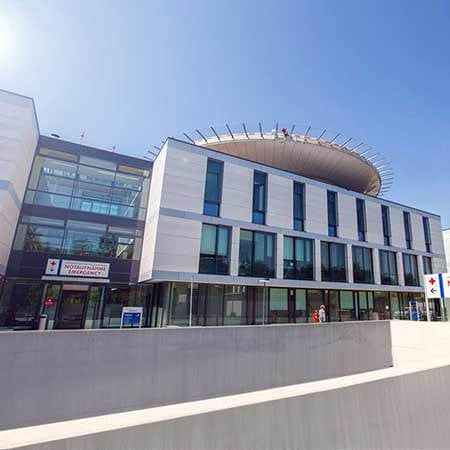Cerebral cavernous malformations, also known as cavernomas or cavernous hemangiomas, are clusters of abnormal blood vessels that do not affect the brain tissue. They bleed slowly, so the average risk of a rupture is lower than in some other malformations. However, cavernomas often cause headaches and epileptic seizures, and the risk of a brain hemorrhage is 1% per year. To avoid complications, you can undergo your treatment for brain cavernoma in Germany. Doctors in this country perform safe microsurgical operations. In some patients, cavernoma can be eliminated by radiosurgery or endovascular techniques.
Content
- Treatment
- Surgical intervention
- Radiosurgery
- Endovascular treatment
Basically, brain cavernomas are treated with the use of microsurgical resection. Stereotactic radiosurgery or embolization is less commonly used. This is explained by the fact that these methods are more sparing but less effective than surgery.
You can undergo your treatment in one of the following hospitals: Sana Hospital Duisburg, Charite University Hospital Berlin, or University Hospital Freiburg.
Please leave your request on the Booking Health website, and we will fully organize your trip to Germany. The Booking Health company will recommend a clinic and a treatment method, make an appointment for your treatment, help you get a visa and arrange your flights, take care of overpricing for foreigners, and provide interpreting services and assistance on any issue.
Treatment
In the case of small and incidentally detected cavernomas that do not manifest any symptoms, the doctors often prefer to use only a watchful waiting. When deciding whether treatment is necessary, they weigh the potential benefits against the risks. Small brain cavernomas are not dangerous since the risk of the hemorrhage is a fraction of a percent per year. Therefore, they are treated if cavernomas cause any symptoms or lead to the hemorrhage.
Below are three groups of methods that can be used for the treatment of brain cavernomas:
- a microsurgical removal;
- a radiosurgical destruction;
- an embolization with platinum coils or a coiling.
Surgical intervention
Cavernoma resection is the most frequently used and most effective method of treatment. The problem is that among all the methods available, the surgical treatment method is also the most traumatic. In some cases, it can be unsafe and requires postoperative rehabilitation. The surgical procedure is preferred in the following situations:
- a single malformation;
- a surface location;
- the presence of symptoms (but patients without any symptoms can be operated on as well).
It is not recommended to use a surgical technique for the treatment of cavernomas, which:
- do not cause any symptoms;
- are multiple;
- are located deep or located in the brainstem.
Even in the case of small cavernomas, many patients have epilepsy, which is drug-resistant. Even if the cavernoma is small and the hemorrhage is unlikely, the presence of epileptic seizures is also considered an indication of surgical intervention.
The healthcare professionals try not to operate on the cavernomas in the brainstem, as it is unsafe. But surgery can still be performed on people who have already had a hemorrhage.
Prior to the surgical intervention, doctors prescribe steroids for 1-2 weeks. They reduce swelling and make it easier to remove the cavernoma. German surgeons strive to remove the cavernoma completely. This is especially important in the patients who have already suffered the hemorrhage since, in such situations, partial resection of the cavernoma leads to repeated hemorrhages with a probability of up to 40%.
Radiosurgery
Stereotactic radiosurgery is an alternative to microsurgery for the treatment of cavernoma. It is mainly used in those who have not yet had a hemorrhage since the effect of the procedure on the risk of repeated hemorrhage remains controversial.
The benefits of radiosurgery are as follows:
- the cavernoma can be eliminated within a single procedure;
- this is a non-invasive and painless method;
- there is no need for rehabilitation;
- there are no complications associated with the operation.
Irradiation is carried out within a single session. The rays are directed to the cavernoma from different sides, which leads to the death of tissues. The mass gradually regresses.
Nonetheless, the method also has a drawback: radiosurgery destroys the cavernoma not instantly but gradually. It has a two-year latent period before the risk of repeated hemorrhages is optimally reduced. Therefore, radiosurgery is not the first-choice treatment. This therapeutic option can be preferred in the following situations:
- contraindications to surgery available;
- a refusal of the operation;
- multiple cavernomas;
- a deep location of the cavernoma, which makes the operation risky.
Radiosurgery is not recommended for familial forms of the disease, in which cavernomas are highly likely to develop in other parts of the brain. It is usually not used for single and superficial lesions that can be easily and safely removed by microsurgery.
Endovascular treatment
The cavernoma can be blocked from inside the blood vessels. To do this, the doctor makes an incision on the leg or arm and delivers microcoils to the vascular mass under X-ray guidance. They cause the formation of blood clots and block the blood flow in the cavernoma, thereby eliminating it from the circulatory system and reducing the risk of hemorrhage.
The advantage of the method is that it is minimally traumatic: there is no need to open the skull, and no long-term recovery is required. However, endovascular treatment is not always effective enough, so it is rarely used as an independent procedure for eliminating cavernoma. Basically, this is just an addition to the operation.
To undergo your cavernoma diagnostics and treatment in one of the German hospitals, you are kindly welcome to use the Booking Health service. You can compare the cost of treatment in different medical centers in order to make an appointment for your treatment at the best price. The specialists of the Booking Health company will select the most suitable clinics in Germany for you and arrange your trip abroad.
Authors:
The article was edited by medical experts, board-certified doctors Dr. Nadezhda Ivanisova and Dr. Sergey Pashchenko. For the treatment of the conditions referred to in the article, you must consult a doctor; the information in the article is not intended for self-medication!
Sources:
WHO - World Health Organization
Verywell Health
Sience Direct














